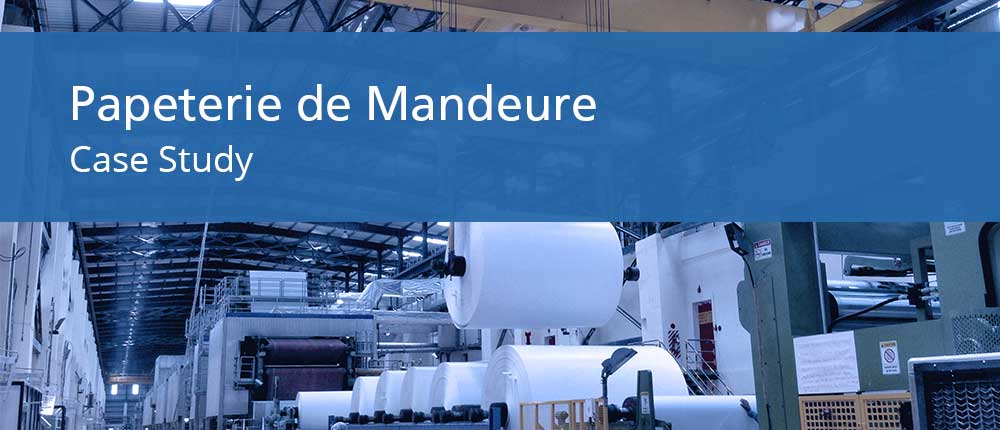System-to-system integration from OT to IT
Papeterie de Mandeure is a paper manufacturer located in the wooded Jura region of eastern France. The company has been producing paper for almost 150 years, specializing in white and colored high-quality paper and cardboards used for graphic design, packaging, and tickets of all kinds.
A strong factor in the company’s continued success over the past century and a half is their willingness to adopt new technologies. Their latest plans are to connect to MES (Manufacturing Execution System) and SAP, to integrate data from their plant into these systems running at head office. As a first step, to gain a clearer picture of their production process, the company has begun using the Cogent DataHub for this real-time data integration.
There are several systems to be integrated. The production machines for the paper-making process are controlled by a Drives system. The auxiliary equipment, such as motors, pumps, and regulators of water pressure, flow, and temperature, is all controlled by a separate DCS system. The plant also uses a Quality Control System (QCS) to measure the quality of the paper product, as well as a Defects Inspection System. Until recently, these four systems operated for the most part autonomously, with operators often conveying information from one system to another manually. Although each system uses one or more OPC servers for data communication, the engineering staff had not been able to connect them together well enough to meet their needs.
“Our challenge was that we have systems from several different vendors,” said Laurent Bulle, Electricity Regulation & Automation Engineer and project lead. “It was not possible for the systems to talk to each other even using OPC. For example, between my Drive systems and DCS system, the OPC communication was active but some data did not pass between the systems and we could not figure it out. Our first goal was to get all our systems talking to each other without any problems.”
In addition to connecting the systems, a second goal was to integrate their data into the company’s MES and eventually to SAP, so that they could start doing cost/benefits analysis on their production. As part of the Clairefontaine Group, Papeterie de Mandeure needs to generate detailed reports of production quantities and costs. “We work very closely with Head Office,” said Bulle. “They have been using the DataHub, and they recommended that I try it. With the help of technical support from Chaimae Khanchoufi at MAC Solutions, our DataHub distributor, I was able to install and configure the DataHub, and make all the necessary connections.”
The requirements for the project were substantial. Data from the Drives OPC servers had to be sent over redundant paths across the network to a server running at a central location. There the redundancy would be resolved, and the data sent on to OPC servers connected to the DCS. At the same time, data from the DCS OPC servers needed to be sent along similar but separate redundant paths through the central server and on to the Drives OPC servers.
Since this was server-to-server communication, OPC bridging was needed on the central server. And since the OPC servers were OPC DA, OPC tunnelling was required. Additionally, the Drives and DCS systems are running on the shop floor, connected to OT (Operations Technology) networks, while the central server runs in the office, connected to the IT network. The OPC tunnels had to connect OT and IT, while security demanded that all firewall ports on the OT network stay closed.
The DataHub was a logical choice for Bulle. “We looked a bit at other products, but honestly not in any depth,” he said. “I was under a deadline to finish this project. I talked with an engineer at our head office, Mr. Thierry Alexandre at Papeteries de Clairefontaine. We collaborated for a day to see what product could address our requirements and we quickly came to the DataHub.”
Bulle installed a DataHub on each OPC server machine, as well as on the central server in the office. He configured OPC client connections to each OPC server, and outbound, redundant tunnelling connections to the central DataHub. On that DataHub he brought the redundant connections back together, and configured the server-to-server bridging required for each connection. He also installed separate DataHubs on the Mandeure QCS and Defects Inspection System machines, configured tunnelling and OPC client connections, and was able to fully integrate both of them into the system. Finally, he used the DataHub’s Database feature to log all the data to a database accessible by the MES.
“We are pleased with the installation,” said Bulle. “We were able to resolve all of our communication issues between systems, and our database is now working. I have left the project to the team that takes care of the MES and I no longer need to touch the system. Everything is functioning very well and we are very happy.”






